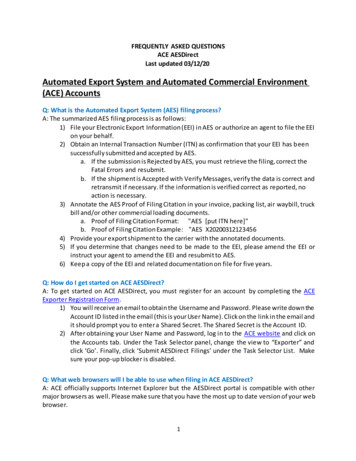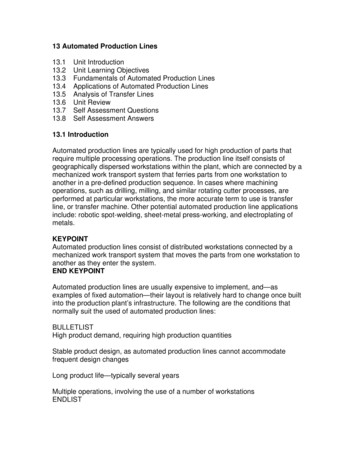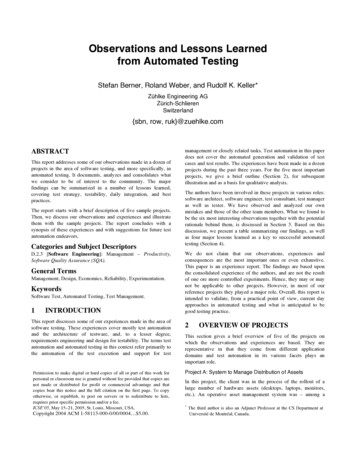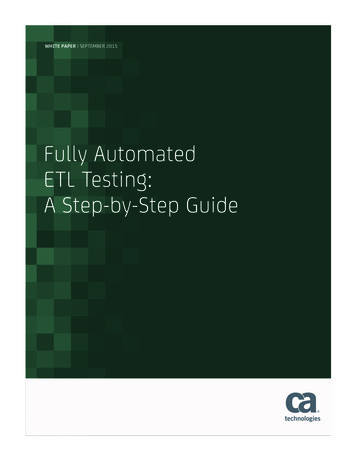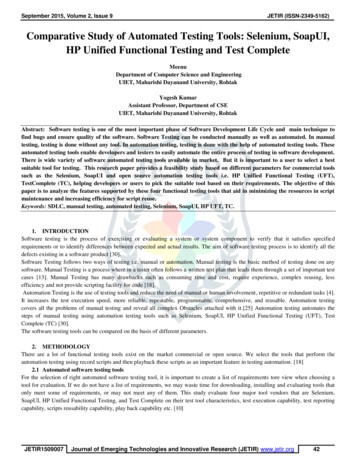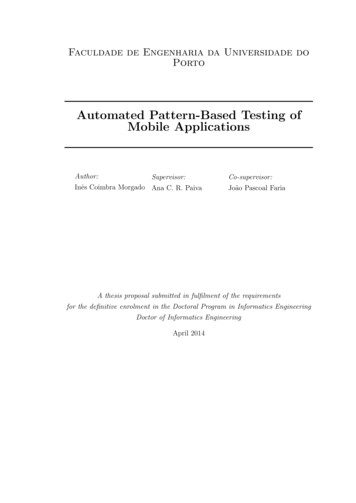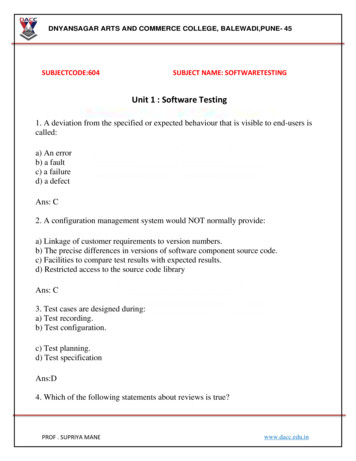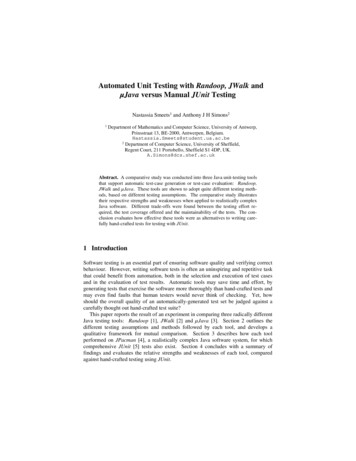
Transcription
Automated Unit Testing with Randoop, JWalk andµJava versus Manual JUnit TestingNastassia Smeets1 and Anthony J H Simons21Department of Mathematics and Computer Science, University of Antwerp,Prinsstraat 13, BE-2000, Antwerpen, nt of Computer Science, University of Sheffield,Regent Court, 211 Portobello, Sheffield S1 4DP, UK.A.Simons@dcs.shef.ac.ukAbstract. A comparative study was conducted into three Java unit-testing toolsthat support automatic test-case generation or test-case evaluation: Randoop,JWalk and µJava. These tools are shown to adopt quite different testing methods, based on different testing assumptions. The comparative study illustratestheir respective strengths and weaknesses when applied to realistically complexJava software. Different trade-offs were found between the testing effort required, the test coverage offered and the maintainability of the tests. The conclusion evaluates how effective these tools were as alternatives to writing carefully hand-crafted tests for testing with JUnit.1 IntroductionSoftware testing is an essential part of ensuring software quality and verifying correctbehaviour. However, writing software tests is often an uninspiring and repetitive taskthat could benefit from automation, both in the selection and execution of test casesand in the evaluation of test results. Automatic tools may save time and effort, bygenerating tests that exercise the software more thoroughly than hand-crafted tests andmay even find faults that human testers would never think of checking. Yet, howshould the overall quality of an automatically-generated test set be judged against acarefully thought out hand-crafted test suite?This paper reports the result of an experiment in comparing three radically differentJava testing tools: Randoop [1], JWalk [2] and µJava [3]. Section 2 outlines thedifferent testing assumptions and methods followed by each tool, and develops aqualitative framework for mutual comparison. Section 3 describes how each toolperformed on JPacman [4], a realistically complex Java software system, for whichcomprehensive JUnit [5] tests also exist. Section 4 concludes with a summary offindings and evaluates the relative strengths and weaknesses of each tool, comparedagainst hand-crafted testing using JUnit.
2 Testing Tools and TechniquesThree different testing techniques (and their associated tools) were chosen for thecomparison. They were chosen to be as unalike as possible, to reveal possibly interesting contrasts. Each testing tool employs a different testing approach and is basedon different underlying testing assumptions.2.1 Feedback-directed Random Testing with RandoopThe Randoop tool [1] generates random tests for a given set of Java classes during alimited time interval, which is preset by the tester. The test engine uses Java’s abilityto introspect about each class’s type structure and generates random test sequencesmade up from constructors and methods published in each test class’s public interface.The testing philosophy is based on random code exploration, which is expected at thelimit to reveal (possibly) all salient properties of the tested code. Randoop has successfully discovered long-buried bugs in Microsoft .NET code [6] and detected unexpected differences between Java versions on different platforms [7].In order to check meaningful semantic properties, the tool requires some priorpreparation of the code to be tested [7]. Firstly, classes under test (CUTs) are instrumented with Java annotations, to guide the tool in how to use certain methods duringtesting. For example, @Observer directs the tool to treat the result of a method as astate observation, whereas @Omit directs the tool to ignore non-deterministic methods and @ObjectInvariant directs the tool to treat a method as a state validitypredicate. Given this information, the tool may construct meaningful regression teststhat observe salient parts of the CUT’s state. Secondly, the tool recognizes certaincontract-checking interfaces as special. Testers may optionally supply contractchecking classes, which implement these interfaces, and so are treated as test oracles,which are executed upon the randomly-generated objects. Predefined contracts typically check the algebraic properties of the CUT, such as the idempotency ofequals(), or the consistency of equals() and hashCode(), but testers may inprinciple supply their own arbitrary contracts [7] (but see 3.1).The feedback-directed aspect refers to the tool’s ability to detect certain redundanttest sequences and prune these from the generated set. In practice, this refers to testsequences which extend sequences that are already known to raise an exception [1].Since it makes no sense to extend a terminating sequence, the longer sequences arepruned. Retained tests are exported in the format expected by JUnit [5]. Randoopclassifies all randomly generated tests into regression tests (which pass all contracts)and contract violations (which do not) and discards tests which raise exceptions.2.2 Lazy Systematic Unit Testing with JWalkThe JWalk tool [2] generates bounded exhaustive test sets for one CUT at a time,using specification-based test generation algorithms that verify the detailed algebraicstructure, or high-level states and transitions of the CUT. The tool constructs a test
oracle incrementally, by a combination of dynamic code analysis and some limitedinteraction with the tester, who confirms or rejects certain key test results. Once theoracle is constructed, testing is fully automatic. If the software, and implicitly itsspecification, is subsequently modified, JWalk only prompts to confirm altered properties. However, the tool does not perform regression testing so much as completetest regeneration from the revised specification [8]. This explains the lazy epithet,whereby a specification evolves in step with changes made to the code and stabilizes“just in time” before testing (c.f. lazy evaluation). The tool could prove a useful addition to agile or XP development, which expects rapid code change and otherwise hasno up-front specification to drive the selection of test cases [9].Fig. 1. JWalk Tester being used to exercise all methods of the class jpacman.model.Cell to adepth of 3, in all distinct interleaved combinations. The test summary tab displays the numberof tests executed. Obscured tabs for each test cycle to depths 0, 1, 2 and 3 list all test sequences and test outcomesIn contrast with Randoop, test sequence generation is entirely deterministic, based ona filtered, breadth-first exploration of the CUT’s constructors and methods, sinceJWalk exploits regularity to predict test equivalence classes, so reducing the numberof examples to be confirmed by the tester. Like Randoop, JWalk prunes longer testsequences whose prefixes are known to raise exceptions. Furthermore, JWalk can alsoprune sequences whose prefixes end in observers (which do not alter the CUT’s state)and whose prefixes end in transformers (which return the CUT to an earlier state).The tool detects these algebraic properties of methods automatically and does notrequire any kind of prior code annotation [10]. It retains the shortest exemplars fromeach equivalence class and uses these to predict the results of longer sequences.
The JWalk tool can be run in different modes which inspect the CUT’s interface,which explore (basically, exercise) the CUT’s methods, or which validate the methodresults with respect to a test oracle. Likewise, test sequences may be constructedfollowing different test strategies, ranging from breadth-first protocol exploration (allinterleaved methods), to smarter algebraic exploration (all primitive constructions andobservations), to high-level state-space exploration (all high-level states and transitions). JWalk regenerates and executes all tests internally, producing test reports [2]and does not export JUnit tests for execution outside the tool. Following the testingphilosophy, exported regression tests would progressively lose their ability to coverthe state-space at a geometric rate, as the tested software evolved [8].2.3 Mutation Testing with JavaFig. 2. The Java tool, seeding mutations in the class jpacman.model.Cell. The traditionalmutants viewer tab displays the original source (above) and modified source (below), in whichthe mutant AOIU 1 (arithmetic operator insertion, unary) has been introduced. Obscured tabsinclude the mutant generator and the class mutants viewerThe Java tool [3] assumes the prior existence of a test suite, created by some othermeans, for testing multiple classes in a package. Mutation testing is intended to evaluate the quality of the test suite by making small modifications, or mutations, to the
tested source code and determining whether the tests can detect these mutants. A testwhich detects a mutation is said to “kill” the mutant; and a successful test may killmore mutants than weaker tests, whereas a mutant that is never detected may revealthe need for more tests, or that the mutation is benign, or that it cancels out anothermutation (“equivalent mutants” [11]), or simply that the code branch containing themutant has not been covered by any of the tests.The testing philosophy is purely code-based, in contrast to the specification-basedor regression-based approaches of the other two methods. The testing method assumes, in the limit, that mutations will mimic all possible coding errors, by introducing every possible kind of fault into the original source code. Tests which kill themutants will also reveal unplanned errors in the source code. Twelve traditional mutants include variable and value insertions, deletions, substitutions, operator replacement and similar changes to code at the method-level [12]. Twenty-nine special mutants are devised to handle class-level mutation, based on a survey of common codingerrors, such as access modifier changes, insertion and hiding of overrides, changes tomember initialization, specialization or generalization of types and typecasts, andinsertion and deletion of keywords static, this and super [13].The testing regime also requires test harness classes, which encapsulate the handcrafted test suites to be run after every mutation series. These are ordinary classeswhose methods are named: test1(), test2(), etc. and which return strings. Thetesting tool is able to compare string-results before and after mutation, to determinewhich tests were affected by the mutations. Though similar in essence, these testsuites are not in the same format as that expected by JUnit.2.4 Experimental Framework and HypothesisThe experiment outlined above was to investigate how well each of the three testingtools performed, compared to an expert human tester. The hypothesis was that thetools might speed up certain aspects of testing, but not fully replace a human tester,although they might make his/her job somewhat easier.The software chosen for the test target was JPacman [4], a Java implementation ofthe traditional Pacman arcade game, developed at TU Delft as a teaching example.The source consists of 21 production classes, amounting to 2.3K SLOC [13]. Thepackage is attractive, since it comes with a comprehensive JUnit test suite, consistingof 60 test cases (15 acceptance tests for the GUI; 45 unit tests for the classes). Thesewere carefully hand-crafted, following Binder’s guidelines [14] to cover all codebranches, populate both on-boundary and off-boundary points, test class diagrammultiplicities and test class behaviour from decision tables and finite state machines.The test code amounts to about 1K SLOC.It was difficult to find a framework in which the three disparate testing approachescould be compared systematically. We considered using code coverage as an unbiased, verifiable criterion, easily measured using the tool Emma [15]. However, Java does not actually generate unit tests and JWalk’s tests were not easily accessibleto Emma. The mutation scores of Java might provide a rough derived indication ofhow much of the code was covered by the hand-crafted tests. Nonetheless, simply
counting how much code executed was not a very sophisticated measure of test effectiveness (was the tested code actually correct?)Time spent on testing was also considered, since one of the main benefits of automated testing is to reduce this overhead. Unfortunately, no measurements were available for the time spent on constructing the hand-crafted JUnit tests; against this, it washard to estimate impartially the time taken to learn the different testing tools (readingonline guides and papers). Simply measuring the time taken to run the tests was alsoconsidered a poor indicator of how effective the tests were, and was also biased, sinceRandoop generates tests up to a preset time limit.For this reason, the comparison between the testing methods is eventually qualitative, focusing mostly on the types of fault, or change, that the tools could detect. Further points of distinction were the amount of extra work the tester had to invest whenusing the tools; and the maintainability of any further generated software.3 Testing ExperimentsEach of the tools Randoop, JWalk and Java were downloaded and installed. Theywere used to test classes from the jpacman.model package, part of the JPacman[4] software testing benchmark developed by TU Delft. Comparisons were drawn asdetailed above; qualitative code coverage and time estimates are also given, wheresystematic measures were not otherwise readily available.3.1 Randoop Testing ExperimentEasy both to install and to use, the Randoop tool randomly generates interleavings ofmethods with randomized input values, bounded by time, not depth. The tool wasexecuted in its default configuration (using the built-in contract checkers), setting timelimits of 1 second, 10 seconds and 30 seconds. The initial experiment aimed to discover how thoroughly the JPacman model classes were exercised purely by randomexecution of the jpacman.model package. Coverage measures were extractedusing Emma for the regression test suite generated by Randoop (viz. disregarding thecontract violation suite). When using a setting of 10 seconds, the generated tests exercised 49.2% of the code, which only increased slightly to 50.5% using the longersetting of 30 seconds. A shorter setting of 1 second only covered 39.9% of the samepackage (see fiig. 3), possibly indicating that 30 seconds was a useful limit.One of the attractions of Randoop is the automated generation of a full regressiontest suite [1]. This can be helpful when working on a project that has no tests whatsoever and for which it is crucial to preserve current behaviour when making changesto the code. However, the kinds of property preserved by these tests were those determined randomly by the tool, arbitrary observations that happened to hold whenRandoop was executed, rather than specific semantic properties of the application. Ifan application is faulty, there is no way of knowing whether these tests monitor correctbehaviour; they merely grant the tester the ability to detect when the behaviour laterchanges.
A potential disadvantage of Randoop was the high cost of test code maintenance.The regression tests generated in 30 seconds ran to some 96K lines of test code, comprising 400 test cases. Some of these used just under 100 variables, with opaque generated names like var1, var2, varN, making any deep understanding of the testprograms impossible. Another limitation of Randoop was the inability to controlvalues supplied as arguments to tests (which were randomized), making it impossibleto guarantee equivalence partition coverage on inputs.Fig. 3. Instruction coverage (basic bytecode blocks) computed by Emma, for the methods ofall production classes contained in the jpackman.model package, for all regression tests generated in 30 seconds by Randoop in its default contract-checking configurationOne potential way to force testing of explicit semantic properties was to use the annotation mechanism (see 2.1). We found that @Observer and @Omit annotationscould be added to the tested source code and processed by Randoop; however, potentially the most useful annotation was @ObjectInvariant, since the JPacmansource code already contained many class invariant() methods, which we couldhave identified for the tool. Unfortunately, the distributed version of the tool we obtained did not appear to process this annotation properly. Ironically, the JPacmansource code already had many conditionally-compiled Java assert() statementswhich could be checked by “turning on assertions” at compile-time, but which threwfatal exceptions when violated, terminating the test run. One future suggestion forRandoop is that it could be made to detect Java assert() statements and convertthese into invariants that could be automatically checked by the tool. We imaginethese could be copied from the source and inserted as the code body of check-methodsin automatically synthesized contract-checkers. We attempted to find out how to writecustom contract-checkers, but the software distribution contained no explicit documentation on how to do this. Randoop is available from the project website [16].3.2 JWalk Testing ExperimentJWalk version 1.0 was easy to install and understand, greatly helped by the comprehensive instructions given on the project website [17]. The distribution contained twotesting tools and a toolkit for integrating JWalk-style testing with other applications,
such as a Java editor. We used the standalone JWalkTester tool, which uploads andtests one CUT at a time. The tool could be run in one of three test modes, coupledwith one of three test strategies.The simplest mode was the inspect-mode, which merely described the public interface of the CUT, listing its public constructors and methods. When coupled with thealgebra-strategy, this also described the algebraic structure of the CUT, identifyingprimitive, transformer and observer methods. When coupled with the state-strategy,this also identified the high-level states of the CUT, where these could be determinedfrom state predicates normally provided by the CUT (e.g. isOccupied() for theclass jpacman.model.Cell). The tool executed the CUT silently for 1-3 secondsto discover state and algebra properties by automatic exploration.In the explore-mode, the tool exercised the CUT’s constructors and methods to achosen depth, displaying the results back to the tester in a series of tabbed panes,organized by test cycle, corresponding to sets of sequences of increasing length.When coupled with the protocol-strategy (see fig. 1), exhaustive sequences were constructed starting with every constructor, followed by all distinct interleavings of methods. The test reports for the protocol exploration strategy were rather too long toreview by hand for CUTs with 10 methods; fig.1 gives the test summary for jpacman.model.Cell, a class with one constructor and eight methods, which produced585 distinct test cases, and did not benefit from any pruning of sequences due to prefixexceptions, since the code did not throw any exceptions.List. 1. Test summary for jpacman.model.Cell generated by JWalk in exploration-mode, usingthe algebraic testing strategy and with the maximum depth set to 3Test summary for the class: CellTest class: CellTest strategy: Algebraic explorationTest depth: 3Exploration summary:Executed 9 test sequences in totalDiscarded 576 redundant test sequencesExercised 9 successful test sequencesTerminated 0 exceptional test sequencesWhen coupled with the algebra-strategy, some seriously effective pruning tookplace (list. 1). The retained tests consisted of set-up sequences of primitive operations(constructors and certain irreducible methods), followed by any single method ofinterest, such as a programmer might wish to write by hand. The pruning rules eliminated redundant sequences
JWalk Tester being used to exercise all methods of the class jpacman.model.Cell to a depth of 3, in all distinct interleaved combinations. The test summary tab displays the number of tests executed. Obscured tabs for each test cycle to depths 0, 1, 2 and 3 list all test se-quences and test outcomes

